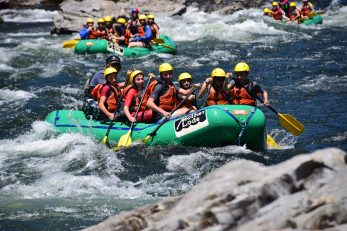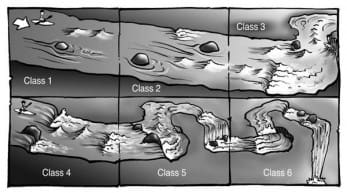
 Whitewater Classes
Whitewater Classes
If you’re looking to book a whitewater rafting trip, you have probably seen a class designation associated with these trips. Whitewater rapids range from class I to class V, but what does that mean?
The whitewater classification system is used as a guide to understand the difficulty of a rapid. The classification system is subjective and often rapids may change classes based on the flow of the river. For example, a Class III rapid may become a Class IV rapid when the river is higher than usual. Also, a section of river will likely have rapids of different classes. This means that sections of river are assigned a class based on the most difficult rapid.
Now that you understand how the whitewater rapid classification system is used, you should understand what each class means.
Class I
Moving water with few to no obstacles. Small waves and ripples.
Class II
Moderate rapids that have a few obstacles and require minimal maneuvering.
Class II is a great option for families with young children on our Family Float Trip.
Class III
More challenging rapids with higher waves, narrow passages, and multiple obstacles.
Class III is fun for everyone, check out our trips on the South Fork of the American River.
Class IV
Long, difficult rapids that require planning and skilled maneuvering in turbulent water.
Class IV is great for experienced boaters, check out our trips on the Middle Fork of the American River.
Class V
Very difficult, long, and technical with many obstacles, strong currents, and steep drops. In the event of an accident, conditions can be life threatening.
Class V rapids can be found on Cherry Creek, the most challenging commercially run river in California. Call (530) 626-4187 if you’re interested in booking!
The guides at Mother Lode River Trips are highly experienced, well trained river enthusiasts. Hop in their boat and they will gladly tell you more about rapid classes and the river features that make white water rafting an adventure loved by all ages!